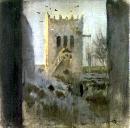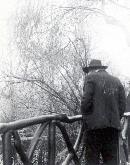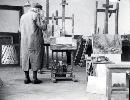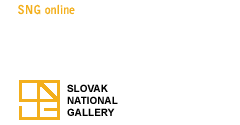
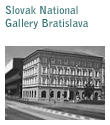 |
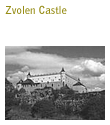 |
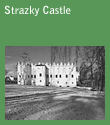 |
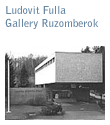 |
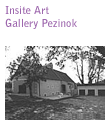 |
|



Collection of Antique Furniture, Gold Pieces and Interior Decorations
The Historical Library
The exhibition of historical portraiture from the 17th—19th centuries
|
Ladislav Mednyánszky and Strážky Mednyánszky The exhibition on view presents a selection from an extensive collection of Mednyánszky’ s works from the early period and documents the stages of development and the path leading to the painter’s style. The artist’s family administered a large collection of his works preserved in an almost compact form, consisting mainly of the works created in 1875—1900. In the later period Mednyánszky did not sell or exhibit any of his works from the early period. During the Second World War part of the collection was destroyed and a considerable collection was transported from Trenčín to Great Britain. After the death of the artist’s nephew Margita Czóbel in 1972, Strážky Chateau and a greater part of his oeuvre came into possession of the Slovak National Gallery. In the year 2000 the collection was completed to include the remaining works from the so-called Strážky bequest. The painter Ladislav Mednyánszky (1852—1919) belongs to the main representatives of Central European painting of the last third of the 19th and the beginning of the 20th centuries, one of the few artists to respond directly to the new streams in painting. He not only absorbed but also transformed them in his work and influenced other artists as well. Ladislav was born in Beckov on 23rd April 1852 to Eduard Mednyánszky and Maria Anna, née Szirmay. When he was baptised on 4th May he was given traditional family names of the Szirmays and the Mednyánszkys – Ladislaus, Josephus, Balthasar, Eustachius. The young family lived in the Beckov Mansion and used to visit his mother’s father, Baltazár Szirmay in the Chateau in Strážky, where they moved after his death (1861). The vigorous temperament of the grandfather, a well read and much travelled man, influenced young Mednyánszky. Apart from European languages, Baltazár Szirmay also mastered some oriental languages. Comparing his character with that of Mednyánszky, we find a lot of similarities. Throughout their entire lives, both of them helped people in need, took a deep interest in social problems and travelled a lot. Like his grandfather, Mednyánszky also kept a diary (in German or Hungarian, using the Greek alphabet), which is an interesting source of knowledge of his personality. Mednyánszky’s childhood was marked by a strong family tradition. The artist’s mother, an educated woman, had a talent for painting and she also encouraged her children to paint. It is said that Mednyánszky could draw before he could speak and he manifested his talent by drawing and scribbling on any paper. The collection of the Slovak National Gallery includes his children’s drawings, which illustrate his vivid imagination strengthened by the domestic environment and fairy tale images of fairies and sprites. The artist had been fascinated by the surroundings of Strážky since his childhood. Apart from the Chateau and the spacious park, Mednyánszky was also interested in the surroundings shaped by the impressive High Tatras: its changing images became his lifelong theme. He was attracted to ordinary people living in the vicinity or working in the Chateau. Since the early childhood, he had developed a close friendship with the local coachmen and peasants. Although he was open and curious, Mednyánszky was a rather timid and shy man and he remained such for the rest of his life. In 1863, Thomas Ender (1793—1875), the Viennese painter and watercolourist, was invited to Strážky. The retired artist showed an interest in Mednyánszky’s talent and decided to assist in Ladislav’s artistic training. He sent several plaster casts of antique heads and reliefs from Vienna and made corrections of Mednyánszky’s drawings, sent to Vienna by his parents. Although Mednyánszky meticulously copied the antique models, he was much more interested in nature that became his frequent subject matter. The meeting of Mednyánszky and the Viennese artist enhanced the development of his talent and focused his attention on drawing and watercolour. After having private tuition and taking his A-level examination at the grammar school in Kežmarok and Miškovec, the young artist began to prepare in Solothurn for further study at the Swiss polytechnic on the initiative of the practically minded family. However, the stay at his uncle’s in Croatia (autumn 1872) inspired him to embark on a different path. He began to paint watercolours that document his trips abroad. With the support of his family, Mednyánszky first studied at the Academy in Munich (1872—1873). After some time he found the Munich academic style unsatisfactory and therefore he enrolled in 1873 at the Paris Ecole des Beaux Artes with Prof. Isidor Pisl (1813/15—1875), the painter of historical and martial themes. After Professor’s death in 1875, he left the school and rented his first studio in Montmartre in Paris, and remained without family support for the first time in his life. The stay in Paris (1875—1877) played an important role in Mednyánszky’s artistic development. He became familiar with the works of the French Impressionists and Post-Impressionists, and later came under the influence of Art Nouveau and Symbolism. Under the influence of French intimate landscape painting (paysage intime) from the surroundings of Barbizon (Jules Dupré, Camille Corot), he began painting forest interiors, nooks and unpretentious landscapes. He detached the landscape from its 19th century composition in order to depict mood and impression. A recurrent theme of this period is reflected in his depictions of trees, a favourite subject already in his childhood. His landscapes often show the motif of path narrowing into one point of the composition. The motifs of the river bend or path becomes the central point of his paintings. The mastery of painting skills led to the artist’s choice of subject matter, often depicting extreme changes of weather (nocturnal landscapes, fogs, storms, rains and twilight). The artist often made written records of his direct observations of nature, which became part of his creative process. His rendition of landscape is more detached -- he perceives landscape as an open composition in which he constantly interferes. During his stay at home in Strážky, Mednyánszky opened a studio, built above the administrative wing of the castle, where he painted and finished his works from France. From the beginning, Strážky was a favourite motif of Mednyánszky’s works. Besides the village landmarks (the Renaissance tower), he was concerned with the closest surroundings of the Chateau, its park, nearby nature and the motifs of the river at its bend near Strážky. This location suited his solitary nature: he used to wander about for hours, studying the changes of nature. At the same time, the melancholy of the place, remote from bigger centres and intellectual seclusion influenced his work. Mednyánszky travelled a lot, changing the place of stay and painting in the studio and in plein air. A great number of his drawings and studies document the artist’s search on his painting path. The portraits and portrait studies of grooms, peasants, coachmen, workmen and tramps formed the second thematic group of Mednyánszky’s oeuvre. He was concerned with the portrayal of common people and outcasts, trying to depict the characteristic features of the portrayed person without taking interest in his social status. In his diaries he made notes about remarkable types of people he encountered. He was a close friend of some of them and supported them throughout his lifetime. The artist’s sister, Baroness Miri Czóbel organised salons, the meetings of artists and literary men at the Chateau of Strážky. Depictions of the Mednyánszky’s family and friends – his brother-in-law Štefan Czóbel, Imrich Czóbel and Zsigmund Justh are a continuation of his portrait work. The close relationship between Justh and Mednyánszky is documented by the fact that the writer described the artist in his novel Fiumus from 1894 in which he represented the character of Lipot Czobor. In response to his mother’s death in 1883, Mednyánszky painted large-scale compositions. He was so deeply struck by the loss of his mother that he avoided going to Strážky until 1887, when he returned to care for the sick during the epidemic of cholera and was taken ill with pneumonia. Until the year 1889 he changed his place of abode, living in Strážky, Beckov, Budapest and Vienna. Apart from several brief visits to his home, he spent most of the time in 1889—1892 in Paris. In the course of the 1890s, especially during his last stay in Paris, Mednyánszky was concerned with depictions of figural compositions with the subject matter of poverty and usurers. The studies of interesting types of people, unfinished from our viewpoint, come from this period. On the contrary, the artist considered his paintings completed as soon as he captured the expression of the portrayed person. On his return to Strážky (1892) and after the death of his father (1895), his works were stamped with the theme of death, displaying a strong melancholic, almost mystic touch. He was concerned with the Spiš stylisation of catafalque portraits similar to those in the Strážky family gallery. Around the year 1900, under the influence of Impressionism, he produced radiant compositions of orchards and vineyards in bloom. The artist detached from the mood of sombre compositions and began to use colours of lighter shades. A turn in his rendition of landscapes came around 1910, when his compositions lacked the symmetry of earlier periods, but showed more vigorous brushwork. This marked a change in Mednyánszky’s work, particularly in his approach to subject matter. He simplified the motifs, reducing them to elementary symbols, applying paint freely in broad brush-strokes. His final paintings are works from the pre-war and war periods, which display the merging of figural and natural motifs. After the year 1900, Mednyánszky spent less time in Strážky. He travelled a lot to Budapest and Vienna, where he was staying when the First World War had broken out. He was 62 years old when he joined the army and worked as war journalist. The war left a strong emotional impact on the artist and was also reflected in his work. The numerous sketches and works that have been preserved show the artist’s preoccupation to connect landscape with the figural motif. In 1916 he was wounded, but a year later he returned to the Italian front. Exhausted from wounds and stressed by the war, he left for Strážky in the spring of 1918. After recovering, the artist returned to Budapest where he continued to work. Towards the end of the year his health deteriorated and he died in Vienna on 19th April 1919. There is a lasting bond between the Chateau in Strážky and the personality of Ladislav Mednyánszky. The collection on view comes from the family bequest and is complemented with the works acquired by the Slovak National Gallery from private collections. In the impressive English park freely connected with the River Poprad and the surrounding landscape, the Slovak National Gallery has been gradually expanding the exhibition of sculpture presenting the works of major Slovak sculptors of the second half of the 20th century from the Gallery collection. Thus the visitors have an opportunity to explore the past and get familiar with the work of architecture, which documents the development of views on residential, official and fortification functions of aristocratic residences from neo-Gothic to Baroque-Classicist forms. The exhibition on view offers the visitors an opportunity to follow the rich and unique development of culture in the Spiš region and get familiar with the exceptional quality of Ladislav Mednyánszky’s work as well as venture into art history through the artefacts from the recent past and the present. up |
|


© 2005 Slovak National Gallery. All Rights Reserved. Web satori.

































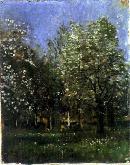
.jpg)
